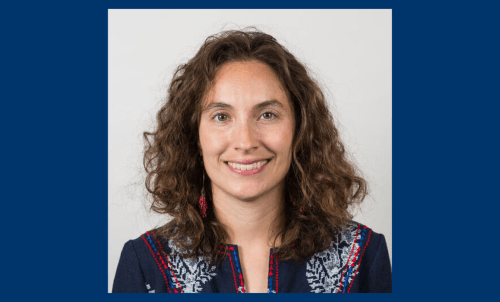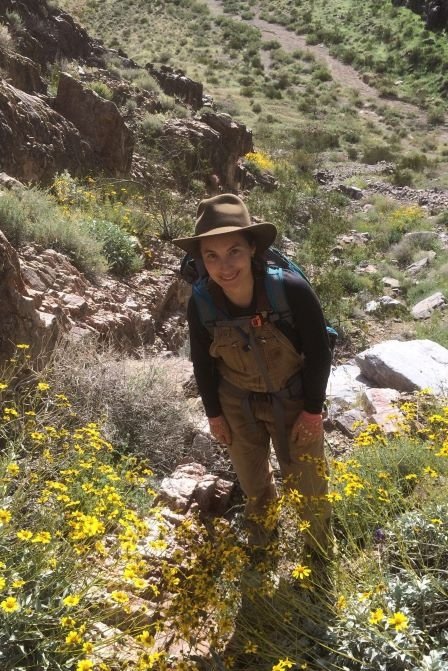Meet the FAS Faculty: Lidya Tarhan
In the field and in the lab, Assistant Professor of Earth and Planetary Sciences Lidya Tarhan is deepening our understanding of early evolution and uncovering ancient organisms in Earth's sedimentary record.

To nominate an FAS faculty member to be featured in this series, please email fas.dean@yale.edu
To the unsuspecting person, a rock might seem like nothing of interest. But to Lidya Tarhan, rocks are the key to time travel, holding fossilized records of the ancient fauna and flora that once inhabited Earth.
Tarhan's findings could rock our world and our understanding of life as we know it. A lifelong enthusiast of the natural world, her research deepens our knowledge of life on Earth, from creatures that swam in past oceans and scuttled across or dug through the ancient seafloor, to tiny microbes, ancient reefs, and some of the earliest life on land.
Tarhan is Assistant Professor of Earth and Planetary Sciences in Yale’s Faculty of Arts and Sciences and Assistant Curator of Invertebrate Paleontology at the Yale Peabody Museum.
Her studies on the sedimentary record—which have answered questions about evolution, ancient oceans, and animals as ecosystem engineers—led to her being recognized with the Yale 2023-2024 Arthur Greer Memorial Prize for Outstanding Scholarly Publication or Research. The award recognizes outstanding research conducted by ladder faculty members in the social or natural sciences who are untenured at the time that the work is completed or published.
This is just the most recent award on Tarhan’s growing list of accomplishments, including a 2023 Sloan Research Fellowship in Earth system science to support her work on the sedimentary record and the 2021 Donath Medal from the Geological Society of America.
Back when she was a first-year student at Amherst College, Tarhan was intrigued by natural history, the study of Earth’s life forms and their habitats. That inkling of interest grew, thanks to Amherst’s resources for studying natural history (including the phenomenal collections of the Beneski Museum). A Summer Research Fellowship with the Howard Hughes Medical Institute, a non-profit science research organization, was yet another chance to explore her growing interests: As a fellow she visited upstate New York, Québec, Ontario, and Wisconsin, and spent ten weeks researching geological impressions in sandstone and ancient tidal flats left behind by some of the earliest animals to creep out of the oceans onto land.
These opportunities for fieldwork and hands-on learning cemented Tarhan's love for geology and created the foundation for her research interests. After receiving her B.A. in geology and English from Amherst, Tarhan went on to get her M.S. and Ph.D. at the University of California, Riverside in geological sciences.
While Tarhan didn’t join the Yale faculty until 2019, Yale has been a monumental influence on her career: she was previously an NSF EAR Postdoctoral Fellow and a Postdoctoral Associate in the Department of Geology and Geophysics (now Earth and Planetary Sciences), during which she focused on the habitats, ecology, and fossilization of Earth’s earliest animal communities.
For Tarhan, Yale has fueled her intellectual pursuits. Now, she hopes to share that excitement with her students, fostering intellectual drive and scientific curiosity amongst the next generation of researchers.
Understanding early evolution of life on Earth
In plain terms, Tarhan says her research investigates “how organisms have interacted with the environments around them throughout Earth’s history.” To understand these complex, ancient relationships she also examines how Earth’s surface has changed on land and underwater, and how those changes influenced the evolution of life and vice versa. This question often leads her on adventures to field sites across the world: she has long researched some of the earliest animal communities known from the fossil record—the soft-bodied organisms of the Ediacara Biota—preserved in the Flinders Ranges of South Australia. For one of her most recent projects, supported by the National Science Foundation’s Frontier Research in Earth Sciences (FRES) program, Tarhan and her group are working with collaborators from Stanford University, the University of California, Riverside, and the Geological Survey of Canada to research some of the earliest plant communities preserved in the rocky outcrops of Arctic Canada.
Tarhan uses a combination of approaches to collect data. She investigates the physical and chemical characteristics of rocks, from the outcrop to microscopic scales, and the diversity, ecology, and preservation of the fossil assemblages they contain with the goal of “reconstructing ancient environments from the rock record,” she says. She and her students and postdocs also conduct experiments in laboratory settings to recreate the conditions that led to the fossilization of past life forms. They also use these experiments to reconstruct how ancient climate and environmental conditions would have impacted the behaviors of ancient organisms, and to forecast how future seafloor communities will respond to anthropogenic climate change.
Once rock samples are taken from the field back to the lab, they undergo a variety of analyses, including detailed assessment of their fossil contents as well as their chemical makeup and structure. These data are then combined with statistical analyses, numerical modeling, and experiments to reconstruct the conditions that led to the deposition or precipitation of these sediments on the ancient seafloor and fostered their preservation in the rock record. The team also analyzes the ecology and fossilization of the ancient life forms their rock samples host. Tarhan tries to understand how different factors could’ve impacted the chemistry of past environments, from the biogeochemistry of the seafloor and overlying ocean waters, to the breakdown and chemical transformation of rocks and minerals in mountain ranges and floodplains of adjacent continental landmasses, and how these conditions in turn shaped past ecosystems.
“One of the advantages of having a longitudinal approach, which encompasses a range of different tools and systems that come from a variety of different disciplines, is that it allows us to be really driven by the questions we’re excited about,” she said.
In early June, Tarhan traveled to western Newfoundland, Canada to explore the province’s geological deposits alongside collaborators from Virginia Tech and Smith College, supported by the NASA Exobiology Program. These deposits record a “key interval” in the evolution of early animal life: they preserve the period between the Cambrian Explosion, an event that began about 530 million years ago during which a wide variety of animals burst onto the evolutionary scene, and the Ordovician Radiation, a period of intense diversification of marine animal life that played out over tens of millions of years.
A key objective of Tarhan’s visit was to determine how major differences in the ocean’s oxygen levels may have impacted ancient marine communities over that interval. “The amount of oxygen that was available in ocean water was much lower than it is today. That might have limited where oxygen-breathing, or aerobic, organisms, like animals, could've lived in the ocean and how active they may have been,” Tarhan said.
Another topic Tarhan’s lab continues to research is the enigmatic Ediacara Biota. They are Earth’s earliest fossilized communities of complex, macroscopic life forms, including some of the earliest known animals, and lived on the seafloor from 570 and 540 million years ago. Because these organisms have in many cases eluded classification among living groups of animals, they are known only from the fossil record, spurring lively debate about their affinities and ecologies.
However, although many of these organisms were unusual in appearance and lived in or on seafloor sediments coated by slimy microbial mats and biofilms, Tarhan and her colleagues are increasingly learning that these communities included the first practitioners of some of the most important behaviors associated with animals today. These include the ability to actively collect nutrients from ocean waters and the seafloor, to move and or burrow into seafloor sands and muds, to sexually reproduce, and even, in rare cases, to precipitate biominerals.
Nonetheless, major questions remain concerning these ancient sea creatures: “Are they related to other groups of animals? What are the processes responsible for their exceptional preservation in the fossil record? Why did they disappear and what can they tell us about the evolution of complex life on our planet?” Tarhan asked, posing some of the big questions that continue to drive her and her colleagues’ research.

Overcoming teaching and research challenges
Like many of her colleagues, Tarhan’s research program faced new challenges during COVID. Despite launching her lab during this difficult time, her team has hit its stride. She shares the excitement of her research with the students in her lab, where she had four Ph.D. students in the 2023-24 academic year. Her first Ph.D. student graduated at the end of 2024 and another joined in the fall, and her group currently also includes two postdoctoral researchers.
“I think we’re in a really good place where we’re starting to leverage the full potential of the instrumentation and equipment that we have in the lab, as well as other resources in the department and elsewhere on campus,” she said. “And we've been able to start going back into the field which has been really exciting as well because this arm of our research program was curtailed during COVID.”
Tarhan teaches a variety of classes at Yale, but the one she most commonly teaches is EPS 232: Earth Surface Processes. The undergraduate course teaches students how to analyze sediment formations in modern landscapes and infer the natural processes and events that led to their creation.
Tarhan mentioned how these natural processes can still be viewed today, from rivers carrying sediment down from mountains to storm events and underwater avalanches transporting sand in the oceans. Through retrospective analysis of sedimentary records of these kinds of events, students reconstruct environmental changes through time, applying their knowledge about how current environmental, climate, and biological conditions shape both ‘background’ processes and episodic perturbations to 'read’ the pages of the geological record.
The class also attracts students with a wide variety of interests. “This class commonly includes not only EPS majors, but also students from environmental studies, ecology and evolutionary biology, astronomy and anthropology, or even humanities majors,” Tarhan says of the unique makeup of her classes. “It’s been a really fun experience for me to be able to engage with folks who have a diversity of backgrounds and perspectives who ask really great questions.”
While Tarhan will continue working on geologic archives, she is expanding her lab research to explore modern coastal seafloor communities, particularly the influence that bioturbators—aquatic burrowing animals, such as shrimp, crabs and worms, that burrow into and churn seafloor sediments—have on their ecosystems, and how they will react to climate change.
“To the general public, it’s not always clear what the connection is between the geologic record and what's happening around us today,” she explains. “But I think that the geologic record has a lot to teach us about not only Earth at the present moment, but also where we might be going in the future.”